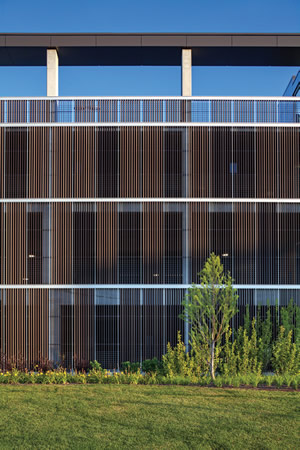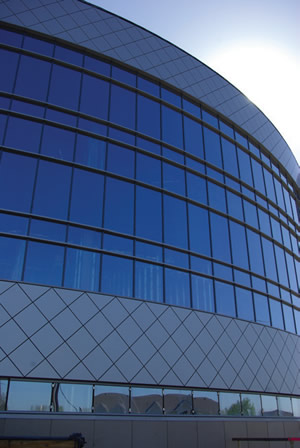Facilities (Campus Spaces)
Who Owns Your Building Envelope?
- By Daniel Shields
- 01/01/17

PHOTO COURTESY OF IWR NORTH AMERICA
Building envelope systems include all the elements of the outer shell of
a structure necessary to maintain a dry, heated or cooled indoor environment
and facilitate its climate control. The owner of the building façade typically hires
a general contractor to assemble a team of subcontractors who will furnish and install
individual systems that will ultimately make up the building envelope. Issues can arise
with the functionality and performance of the building envelope at various stages of the
process, from pre-construction design through execution of the warranty.
Design
The design-assist approach is a project
delivery method in which the construction
team is engaged by the building owner to
collaborate with the design team earlier
in the process. This concerted teamwork
approach streamlines the design process
and allows for primary parties to be
involved from start to finish, enabling each
participant to ask questions and make
recommendations along the way. Coordination
of the design details is essential to
achieving a façade that is highly efficient
and performs as expected. Alternatively,
in the traditional design-bid-build delivery
method, it is often too late or too costly for
the building owner to address an issue or
concern with the design.
In a design-assist approach, one of the
most important elements is determining
who is accountable for each of the responsibilities
necessary in the design process.
Contractually this is very important as
everyone on the team plays a key role, and
this can lead to confusion on where the
professional obligations fall. Consequently,
it is imperative that the roles and responsibilities
of each party be clearly identified at
the beginning of the design phase in order
to reduce waste and establish accountability.
Without the clear identification of the roles and responsibilities, ambiguity can create issues of ownership
of the professional liability.

PHOTO COURTESY OF IWR NORTH AMERICA
In addition to ownership of design responsibility, it is crucial to
have a clear signal of when the design phase has ended and the construction
phase begins. If there is not clear identification, the project
schedule is in jeopardy, often causing a delay in completion.
Typically, multiple companies are hired to enclose the building,
each bearing responsibility for different systems that will ultimately
need to work in unison. Unfortunately, if several subcontractors
perform the work in segments during the design phase,
the tendency moves toward only concentrating on factors specific
to their own detailing. This will lead to failure of true analysis of
the adjacent systems and their resulting compatibility with the
next subcontractor. A design-assist approach is arguably one of
the best ways to achieve true collaboration on both the elements of
design and installation of the building envelope system.
Transitions
Transitions between each system of the building envelope
require careful management to avoid potential moisture and air
infiltration issues. Subcontractors often detail up to the adjacent
system with a generic description of “by others.” This approach
becomes problematic when other subcontractors are following
suit and drawing their system up to the same transition point and
also labeling it “by others.” The individual systems are typically
submitted as separate proposals to the general contractor, and
the lack of detail at the area of transition will be the weakest link
of the design. As a result of the deficiency of coordination at the
transition between systems, the exterior wall is now susceptible to
permitting the infiltration of both air and water.
The general contractor or construction manager is typically responsible
for coordination of these transitions within the building
envelope. The general contractor must decide who goes first, who
is responsible for the scope of work at each transition and if there
are any warranty gaps. Proper detailing and review of the systems
and materials with focus at each transition is the most effective
plan of quality control during the construction process.
One option to reduce performance conflict at transition areas is
to hire a subcontractor that handles the entire building enclosure.
Companies are starting to employ a building enclosure partner
philosophy by widening their capabilities in order to handle the
entire building envelope scope. Having an all-in-one approach
eliminates the common issues of lack of communication and poor
coordination that arise when using multiple subcontractors.
Schedule
Construction schedules set at the beginning of the process are
seldom right. There are factors, such as weather, that impact a
project schedule and are out of anyone’s control. However, one of
the main issues that frequently causes delay is that multiple companies
are involved in the construction process. Each company
requires direction and management, increasing the possibility of a
modified project schedule.
To decrease the chances of a late schedule, it is important to drive
each design phase conversation in the direction of cost, performance
and schedule, leaving each meeting with clear direction. Alternatively,
hiring one building enclosure contractor in lieu of multiple subcontractors
can help eliminate the time necessary to coordinate the vast
amount of details required and keep a project schedule on time.

PHOTO COURTESY OF IWR NORTH AMERICA
MIND THE GAP. Your building envelope protects what is inside your building from what is
outside; in particular, moisture. Because all of the possible moisture-related issues in new
construction are not always immediately apparent to an architect, the entire design and
construction team — or teams — must tackle design issues relating to the architectural
aspects of building. Therefore, it is vital that there be no gaps in knowledge, intent or
responsibility as the building envelope is assembled in order for the result to be a secure,
functioning facility.
Coordination
Trade coordination is required when multiple subcontractors
have been hired to furnish and install the complete building
envelope. The process of trade coordination is important because
it allows questions presented by the ownership and design team to
be addressed, ensures that the full scope of work is captured and
the overall design is understood.
Trade coordination meetings are challenging because they
require all parties to come together for review. It can be difficult
to organize a time and place in which everyone is available. This
challenge is emphasized when a project schedule is disrupted and
meetings must be pushed back or cancelled. In order to ensure that
a project is on time, on budget and performs well, these coordination
meetings are paramount.
In addition to timing issues, responsibility for gaps in the project’s
scope of work is often met with resistance because each subcontractor
is working to mitigate risk for the benefit of his or her own company.
These issues could be eliminated by working with a building enclosure
partner versus several subcontractors. The building enclosure
partner owns the practices and the procedures, giving the owner and
general contractor or construction manager a single point of contact.
Warranty
Manufacturer warranties of the building envelope system
components are usually passed from the manufacturer through to
the owner. Some warranties have at least a decade-long timetable
and can provide peace of mind to the building owner. The manufacturer
warranty covers the performance of the product. Labor or
workmanship warranties are regularly required on installations
and have a typical coverage period of two years. This coverage is
adequate because the building will see two full cycles of spring,
summer, autumn and winter. If any poor workmanship exists, it
can be flushed out and corrected within the warranty timeframe.
One issue that can occur with these types of warranties is if the
system failure occurs outside of the workmanship timeframe. For
example, glass typically has a 10-year warranty, and if there were
a product failure at year six, the glass manufacturer would replace
the glass under its warranty. However, the owner of the building
would still be responsible for costs associated with the installation
of the replacement glass.
Another issue that can arise when multiple subcontractors are
involved in the construction is with identifying the source of the
problem so that responsibility can be assigned to the appropriate subcontractor.
In areas of ambiguity, due to poor coordination and scope
of work clarification, warranties become even harder to enforce.
Warranties play a large role in the owner’s decision on what
companies to hire. The owner is looking for the added confidence
that the building will perform well after construction has been
completed. One of the biggest owner concerns of warranties is with
the inclusions and exclusions in the scope of work. Typically, the
area that tends to have the most common failures is at transitions,
where one system stops and another system starts. This is where
the issue of “who owns what” tends to be a gray area and reveals a
gap in the warranty coverage.
Conclusion
The management and coordination of the design and installation
of a building envelope system is the core factor that can
prevent or cause performance issues. Communication is the key
element in preventing building performance failures or issues. A
collaborative approach from start to finish, including the design
phase, works better to ensure a high-performing façade. The best
approach and one that companies are gravitating toward is the
managed building enclosure, in which one contractor is responsible
for the scope, performance and warranty of the entire building
envelope system.
This article originally appeared in the issue of .